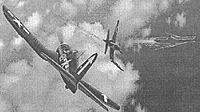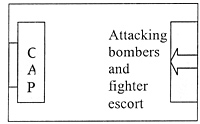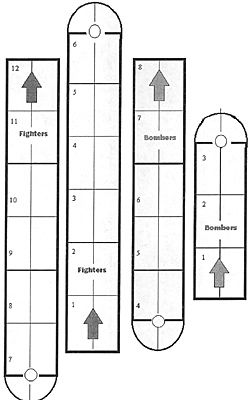 I. The Purpose.
I. The Purpose.
- To create a game with the carrier war in the Pacific as the theme
To create rules that can be used by one or two players
II. EQUIPMENT
- A large board (a long dining table, ping-pong table, bed top, or floor)
Small model planes (metal 1/285, or paper)
- American: 6 F4F Wildcats; 4 SBD Dauntlesses; 4 TBF Avengers
Japanese: 6 Zeros; 6 Vals; 3 Kates
Two paper rectangles approximately 2 inches wide and 10 inches long representing U.S. and Japanese carriers.
III. ORGANIZATION
- U.S. fighters are placed on the board in sections of two, Japanese fighters in shotais of three.
Fighter units may divide for single combat anytime after the game begins.
IV. PHASES
- The game is divided into two phases:
- U.S. attack
Japanese attack
- Combat Air Patrol (CAP) defense for carriers is composed of six planes (two Japanese fighter shotai or three American fighter sections).
Fighter escort for the attacking bombers of both sides is also composed of six planes.
V. OBJECTIVES
- The side that sinks the other side’s carrier without losing its own wins the game with a major victory.
If neither side sinks the other’s carrier, or if both sides sink the other’s carrier, add up the bomb hits and the side that scored the most hits wins a minor victory.
VI. PLACEMENTS
- A. Placing the carrier on the board
- The carrier should be placed on the end opposite to the enemy’s entry.
The carrier should be centered on the edge of the board. (see Figure 1)
- Attacking bombers and fighter escorts should be placed in an area no farther than 12” from the edge of entry.
Attacking airplanes may be placed in any formation within the entry area.
- The CAP should be placed within 12” of the carrier’s edge of the board.
The CAP begins the game by moving first.
- When attacking or defending fighters are placed on the board, roll to see if the shotai or section is above, below, or even with the bombers.
Roll 1 D6: 1, 2 = below; 3, 4 = even; 5, 6 = above.
Place a coin beside the fighter elements that are above or below the bombers. Turn the coin to heads if the plane is above and tails if the plane is below.
The distance of the first move by the fighters will be determined by their altitude.
- If a plane is above the bombers, add six inches to the regular move to indicate a dive.
If a plane is below the bombers, subtract six inches from the regular move to signify a climb.
If a plane is level with the bombers, move a regular move.
All subsequent moves are the regular distances.
 Figure 1. Placement of Defending and Attacking Aircraft
Figure 1. Placement of Defending and Attacking Aircraft
VII. Engagement
- A. Attacking escort fighters automatically move to intercept the closest defending CAP fighters.
The primary objective of the CAP fighters is to engage the attacker’s bombers, but they may break away for dogfights when escort fighters come closer than the bombers.
Movement
- Wildcat, Zero = 12”
Dauntless, Avenger, Val, Kate = 8”
Fighters
- Fighters must move straight ahead for 6” before turning.
Fighters may turn any direction and move the remainder of their movement.
A damage point reduces the final movement of fighters by 2”.
- After moving 3” straight ahead, bombers may change direction up to 90 degrees.
Movement for a bomber is reduced 2” for each damage point
- A fighter may stop to fire at a target, but it must continue its movement afterwards.
Before stopping to fire, measure the complete distance of movement and place a marker (a washer) at the projected end of the move.
- offensive values
- fighters = 3
bombers = 1
- All U.S. planes = 2
All Japanese planes = 1
- The attack range for planes is 4”.
A plane may attack only one time during its movement turn.
If the attacking airplane is directly behind the target, add 1 point to the offensive value of the attacker.
- a. The carrier has an offensive value of 3 (shooting at planes), and a defensive value of 1 (dodging bombs and torpedoes).
A carrier may attack all planes within 12” during its turn.
- Roll 1 D6 for the attacker and 1 D6 for the defender.
Add the offensive value to the attacker’s number and the defensive value to the defender’s number.
If the defender’s score is equal to or more than the attacker’s, there is no damage.
If the defender’s score is less than the attacker’s score, but not doubled, an engine is damaged—or, if the engine is already damaged, the plane is destroyed.
If the defender’s score is doubled or more by the attacker’s score, the plane is destroyed.
VIII. THE BOMB RUN
- Bomber approach
- 1. A carrier is protected by many AA emplacements, which give it an offensive value of 3.
2. Carriers can fire once per turn at every enemy plane within a 12” range.
3. To determine if the bomber is hit by flak before it can drop its bombs, the carrier rolls 1 D6 using its AA value of 3 against the 1 D6 roll and defensive value of the bomber. If the bomber is not destroyed, it continues the bomb run on its next turn.
- The fuselage of the dive bomber must be over the carrier rectangle in order to drop bombs.
Bombers receive 1 D6 roll to attack whether damaged or not.
To determine the number of bomb hits, the bomber and the carrier each roll 1 D6.
Add the offensive value to the bomber’s number on the die and the defensive value to the carrier’s number (the bomber has an offensive value of 1, and the carrier has a defensive value of 1).
- If the defender’s total score is more than the attacker’s, there is no damage.
If the defender’s score is less than the attacker’s score, but not doubled, 1 bomb hits.
If the defender’s score is less than the attacker’s score and is doubled or more, 2 bombs hit.
d. Three bomb hits will destroy a carrier.
- The process is the same as for the dive bomber with this exception; the torpedo may be released 6” from the carrier. The torpedo bomber does not have to be directly over the carrier when it attacks. (The torpedo bomber may be shot down after its attack if it is still within range of the carriers guns.)
The torpedo bomber has an offensive value of 1 versus the carrier’s defensive value of 1. Because of unreliable torpedoes, however, USN Avengers have an offensive value of 0 and will use an unmodified 1D6 roll to determine hits.
Torpedoes have the same effect as bombs. When the die roll is double or more than double the carrier’s score, the torpedo has the effective damage of two bombs.
The combined damage equivalent to three bombs will sink the carrier.
Design Notes
1. The Japanese planes were more flimsy than the U.S. planes due to lighter construction, lack of armor, and poor self-sealing gas tanks. The Japanese an given an extra plane and the U.S. Avengers are penalized in order to add balance to the game. Historically, the Japanese often outnumbered U.S. forces, and the U.S. torpedoes were notoriously defective in the early part of the war; thus, the balance is reasonable.
2. The smallest Japanese unit was the three-plane shotai which often flew in a “V” formation. The smallest U.S. unit was the two-plane element or section. The use of these units adds to the historical “feel” of the game.

Pacific Carrier Strike WWII Wargame Scenario
- Rules
US and Japanese Carriers
US and Japanese Aircraft
Color: US and Japanese Carriers, Aircraft, and Rules (slow: 174K)
Back to Table of Contents -- Lone Warrior # 144
Back to Lone Warrior List of Issues
Back to MagWeb Magazine List
© Copyright 2003 by Solo Wargamers Association.
This article appears in MagWeb (Magazine Web) on the Internet World Wide Web.
Other articles from military history and related magazines are available at http://www.magweb.com
